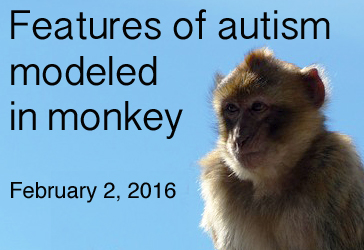Check out other stories from the Latest News
Macaque Monkey Model Exhibits Autism-Like Behaviors
By Anjali A. Sarkar, Ph.D. on February 2, 2016

Background: Mutations in the MECP2 gene cause Rett syndrome, a brain disorder with autistic features that affects girls almost exclusively. However, extra copies of the MeCP2 gene results in core symptoms of autism spectrum disorder mostly in boys. Although mouse models of Rett syndrome exist, investigations on the role of additional MeCP2 copies using the mouse model have proven to be difficult as mice with excess MeCP2 protein fail to develop symptoms reminiscent of autism.
What's new: On January 25, 2016, the journal Nature published a study on the effects of excess MeCP2 gene products in the monkey brain. Neuroscientists at the Chinese Academy of Sciences in Shanghai generated genetically engineered macaque monkeys that expressed multiple copies of the human MeCP2 gene, specifically in the neural tissue of the brain. When compared to a control group, the monkeys with extra MeCP2 showed the signature behavioral traits of autism: increased frequency of repetitive circular locomotion, increase anxiety, reduced social interaction, and relatively weak signs of cognitive impairment.
Why it’s important: This study introduces a new macaque monkey model mimicking human MECP2 duplication syndrome that includes core features of autism. Given the close lineage, monkeys may offer an improved model for autism spectrum disorders by opening-up novel therapeutic possibilities.
Help me understand :
| Source(s) : |
| Tweet |

